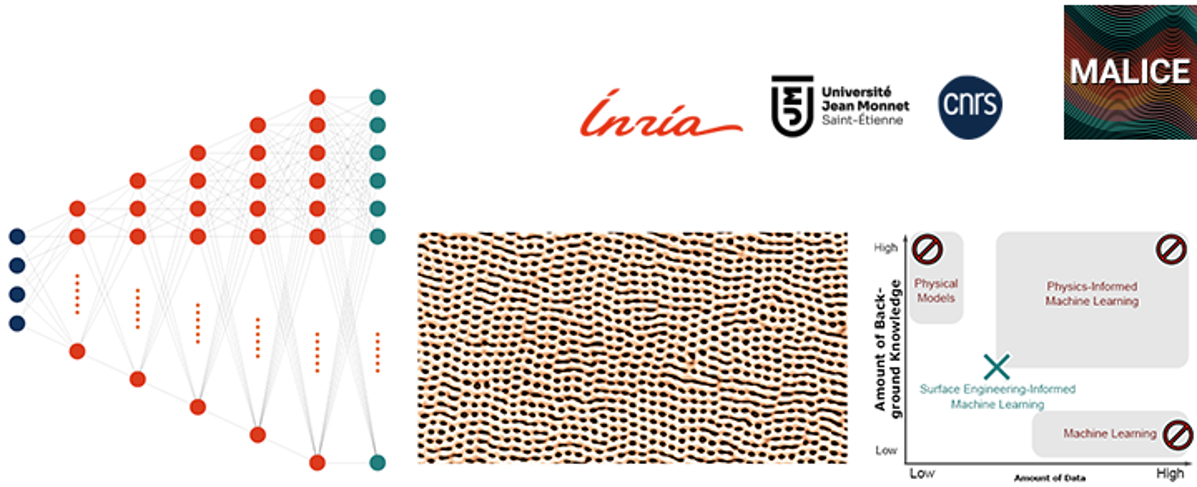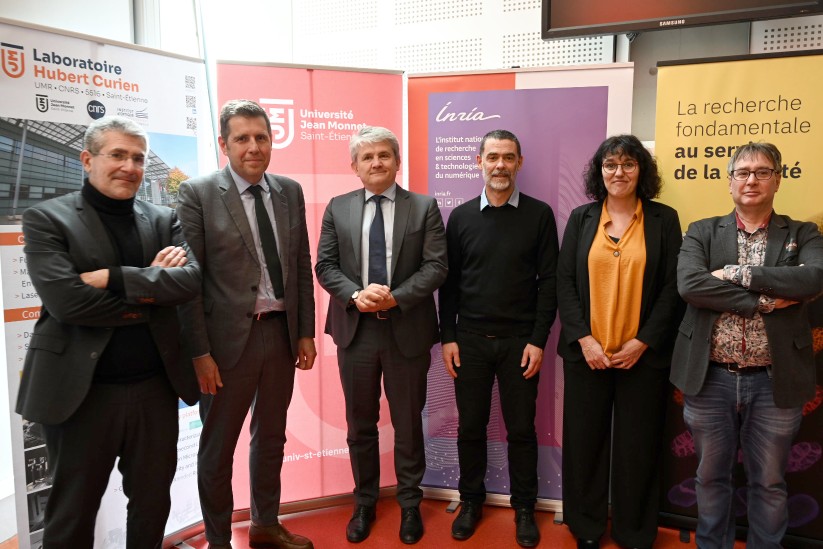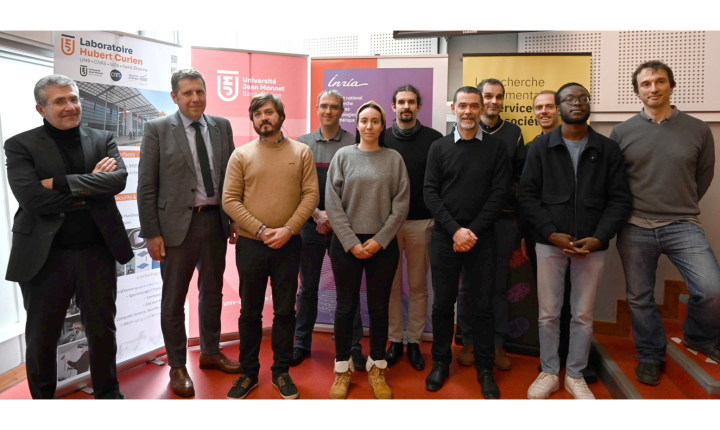Inria MALICEA new project-team for our lab
Inria, the University Jean Monnet Saint-Étienne and the CNRS have created a joint project-team for the development of new methodologies in machine learning to address major scientific and technological challenges related to surface engineering. The new project-team, named Malice (MAchine Learning with Integration of surfaCe Engineering knowledge: Theory and Algorithm) is hosted in our lab and is led by our Data Intelligence team member Marc Sebban. The official inauguration of MALICE took place on 26th March 2024.
While embedding physics knowledge into Machine Learning to enhance a Neural Network’s predictive capabilities is a prevalent trend in contemporary scientific research, MALICE distinguishes itself by tackling physics laws that are not yet fully mastered. Specifically, the team addresses the complex mechanisms governing self-organizing phenomena that emerge from the interaction between laser light and matter, a technique pivotal in Surface Engineering applications.
Marc Sebban, head of MALICE, emphasizes the potential mutual benefits of the research for both domains. Surface Engineering raises numerous Machine Learning challenges, including limited access to training data, partial and incomplete background knowledge, the need to derive theoretical generalization guarantees for models learned from both data and physical knowledge, and the necessity to transfer knowledge across distinct learned dynamical systems. On the other hand, the advances that will be made in Machine Learning will improve our understanding of the physics underlying the mechanisms of laser/radiation-matter interaction. Mastering the physics driving light coupling and its resulting self-organized patterns could indeed enhance one’s capability to impart specific properties to a material, paving the way for improvements in mechanical strength, wear resistance, corrosion protection, biocompatibility, adhesion, etc.

Our lab’s distinctive combination of expertise in both statistical learning and surface engineering has been the catalyst for such new venture. Collaborative work between our Data Intelligence, Laser-Matter Interaction, Functional Materials & Surfaces groups began a few years ago, and has already led to the publication of several articles in prestigious physics journals (Physical Review Letters, 2023; ACS Nano 2022). The objective for MALICE over the next few years will be to maintain this dynamic of interaction between both disciplines, in order to initiate new collaborations on other aspects of Surface Engineering. This should be facilitated by the recent addition of two new researchers to our lab and the MALICE project-team, which currently comprises the following permanent staff members: Dr Farah Cherfaoui (UJM), Dr Rémi Emonet (UJM), Dr Rémi Eyraud (UJM), Dr Jordan Frecon (UJM), Dr Benjamin Girault (Inria), Prof. Amaury Habrard (UJM), Prof. Marc Sebban (UJM), and Naïma Chalais Traoré (UJM). The group will soon be completed by future Inria Research Scientist Dr Quentin Bertrand, who is expected to join us in July 2024.
The establishment of MALICE marks the addition of a 16th project-team to the Inria Lyon Centre, the first to be located in the Saint-Etienne area. The project aligns with the Centre's objective to foster new interdisciplinary research initiatives, particularly in the fields of digital and engineering. As pointed out by Bruno Sportisse (CEO of Inria) during the inaugural event, "The creation of this new interdisciplinary team concretely illustrates Inria's commitment to supporting scientific risk-taking and the pursuit of greater impact, with its academic and university partners, in a promising field where the challenges are significant. We are very pleased to continue developing our presence in the Auvergne-Rhône-Alpes region, strengthening the collective dynamics of the higher education, research, and innovation ecosystem around Lyon and Saint-Étienne, at the heart of France's leading industrial region."
The project is also in line with the University Jean Monnet’s scientific strategy, which revolves around four distinct structural axes, including the Photonics-Surface-AI domain. Florent Pigeon (President of the University Jean Monnet) commented: "Our university is particularly pleased to welcome the Inria Malice team to Saint-Étienne. Benefiting from complementary expertise in machine learning and surface engineering, developed within the Hubert Curien Laboratory and recognized at the highest international level, this team, unique in its kind, illustrates the scientific excellence of the activities carried out within this unit. This new collaboration with Inria fully aligns with Jean Monnet University's strategy to develop leading interdisciplinary activities with very high economic and societal potential in the strategic axis of 'Photonics-Surfaces-AI' of the institution."

From left to right: Bruno Sportisse, CEO of Inria; Florent Pigeon, President of the University Jean Monnet Saint-Étienne; Gabriele Fioni, Deputy Rector for Higher Education, Research & Innovation, Auvergne Rhône-Alpes Academic Region; Prof. Marc Sebban, head of the Malice team; Florence Garrelie, Director of the Hubert Curien Laboratory; Stéphane Ubéda, Director of the Inria Lyon Centre.
For further information:
Visit Inria's website
Visit the Université Jean Monnet's website
Download the Inria/UJM/CNRS press release
Articles recently published in the press regarding the new MALICE project-team:
- If Saint-Etiennne: Ingénierie des surfaces : avec Malice, le labo Hubert Curien espère aller plus loin
- L'Essor Loire: Intelligence artificielle : l'Inria s'implante à Saint-Etienne
- AEF Info (subscribers only): Saint-Étienne : création d’une nouvelle équipe-projet (Inria-CNRS-UJM) consacrée à l’ingénierie des surfaces

